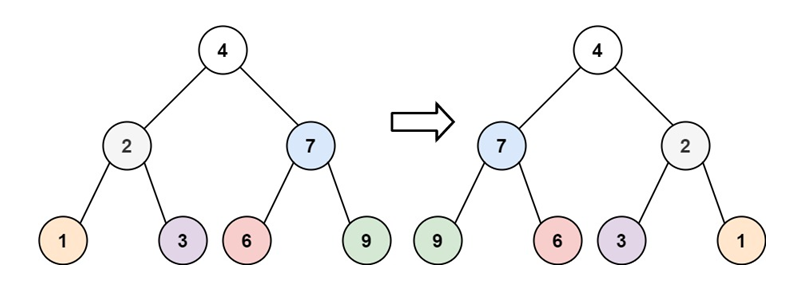Problem Statement
Given the root of a binary tree, invert the tree, and return its root.
LeetCode:
Constraints:
- The number of nodes in the tree is in the range
[0, 100]. -100 ≤ Node.val ≤ 100
Examples
Example 1:

Input: root = [4, 2, 7, 1, 3, 6, 9]
Output: [4, 7, 2, 9, 6, 3, 1]Example 2:

Input: root = [2, 1, 3]
Output: [2, 3, 1]Example 3:
Input: root = []
Output: []Different Approaches
1️⃣ Recursive Approach
Intuition:
Recursively visit each node in post-order fashion (or pre-order), swap its left and right children, and continue down the tree.
Approach:
- If the current node is
nullptr, return. - Swap the left and right child nodes.
- Recursively do the same for the new left and right childen.
Code:
class Solution {
public:
TreeNode* invertTree(TreeNode* root) {
if (root == nullptr) return nullptr;
// Swap the left and right children
swap(root->left, root->right);
// Recur for left and right subtrees
invertTree(root->left);
invertTree(root->right);
return root;
}
};
Complexity Analysis:
- Time Complexity:
O(n)- Every node is visited once.
- Space Complexity:
O(h)his the height of the tree due to the call stack. Worst caseO(n), best caseO(log n)for balanced trees.
2️⃣ Iterative Approach (Using Queue - BFS)
Intuition:
Use level-order traversal (BFS) with a queue. At each node, swap the left and right children.
Approach:
- Initialize a queue and push the root.
- While the queue is not empty.
- Pop a node from the queue.
- Swap its left and right children.
- Push non-null children into the queue.
Code:
#include <queue>
class Solution {
public:
TreeNode* invertTree(TreeNode* root) {
if (root == nullptr) return nullptr;
std::queue<TreeNode*> q;
q.push(root);
while (!q.empty()) {
TreeNode* current = q.front();
q.pop();
// Swap left and right
swap(current->left, current->right);
if (current->left) q.push(current->left);
if (current->right) q.push(current->right);
}
return root;
}
};
Complexity Analysis:
- Time Complexity:
O(n) - Space Complexity:
O(w)wis the maximum width of the tree, in the worst case it could beO(n)
3️⃣ Iterative Approach (Using Stack - DFS)
Intuition:
Use a stack to perform a DFS traversal. At each node, swap left and right children.
Approach:
- Use a stack to simulate DFS.
- At each node, swap the children.
- Push non-null children into the stack.
Code:
#include <stack>
class Solution {
public:
TreeNode* invertTree(TreeNode* root) {
if (root == nullptr) return nullptr;
std::stack<TreeNode*> st;
st.push(root);
while (!st.empty()) {
TreeNode* current = st.top();
st.pop();
// Swap children
swap(current->left, current->right);
if (current->left) st.push(current->left);
if (current->right) st.push(current->right);
}
return root;
}
};
Complexity Analysis:
- Time Complexity:
O(n) - Space Complexity:
O(h)his the height of the tree (stack size in DFS). Worst case:O(n)
